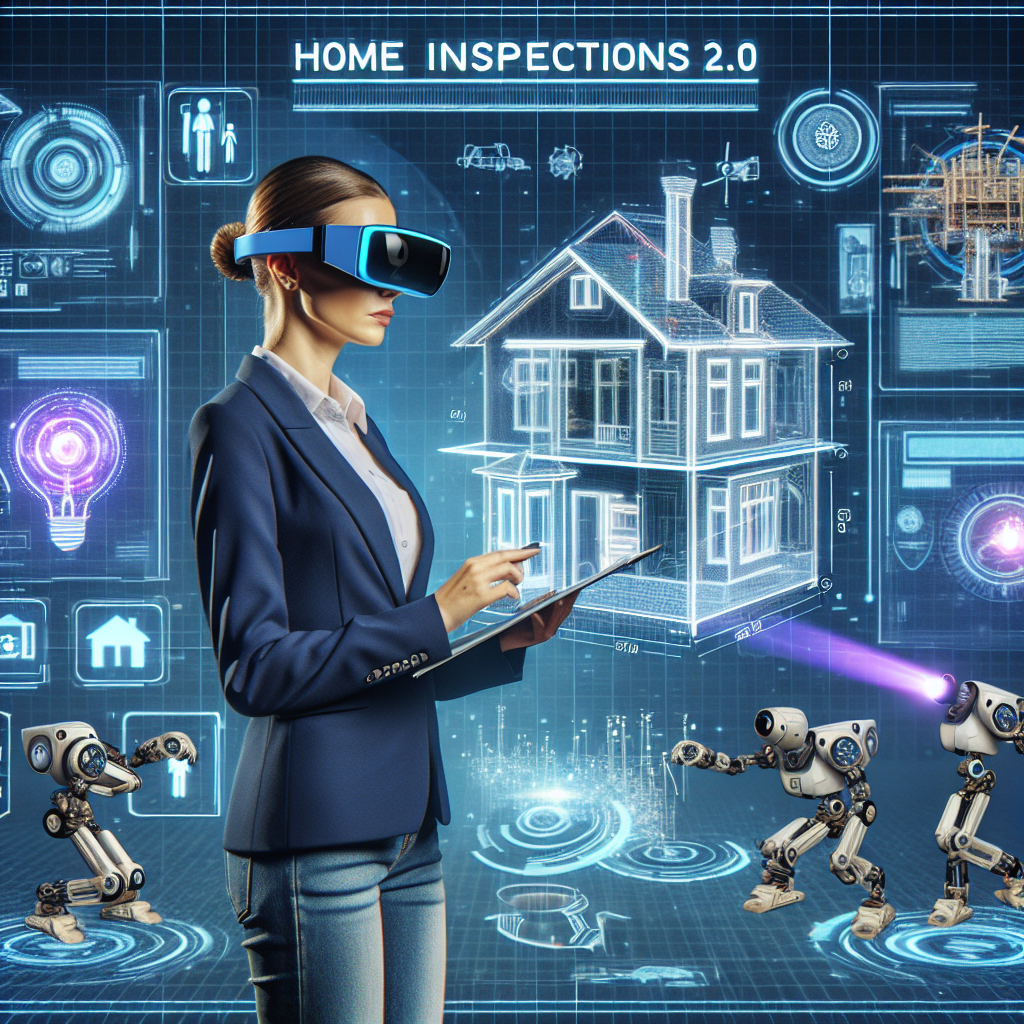Home Inspections 2.0: Harnessing the Power of Technology is an innovative approach to home inspections that leverages advanced technological tools and solutions to enhance the inspection process. By incorporating cutting-edge software, digital imaging, drones, and other smart devices, Home Inspections 2.0 aims to improve accuracy, efficiency, and overall quality in assessing the condition of residential properties.
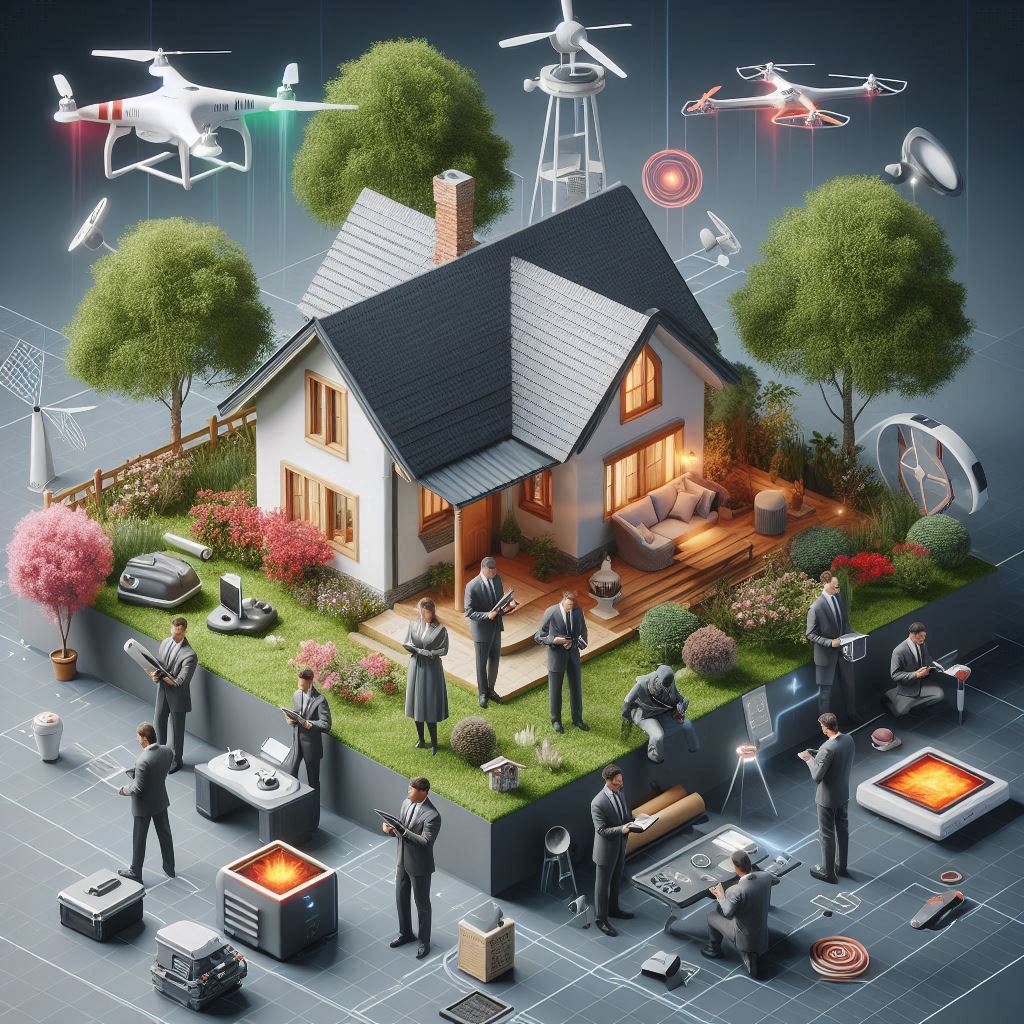
This next-generation approach brings numerous benefits for homeowners, buyers, sellers, and real estate professionals by providing more comprehensive insights into a property’s structural integrity, energy efficiency, safety features, and potential maintenance issues.
The Benefits of Using Drones for Home Inspections
Home inspections have long been a vital part of the real estate industry, providing valuable information to both buyers and sellers about the condition of a property. Traditionally, these inspections involved a physical visit by an inspector who would meticulously assess various aspects of the home.
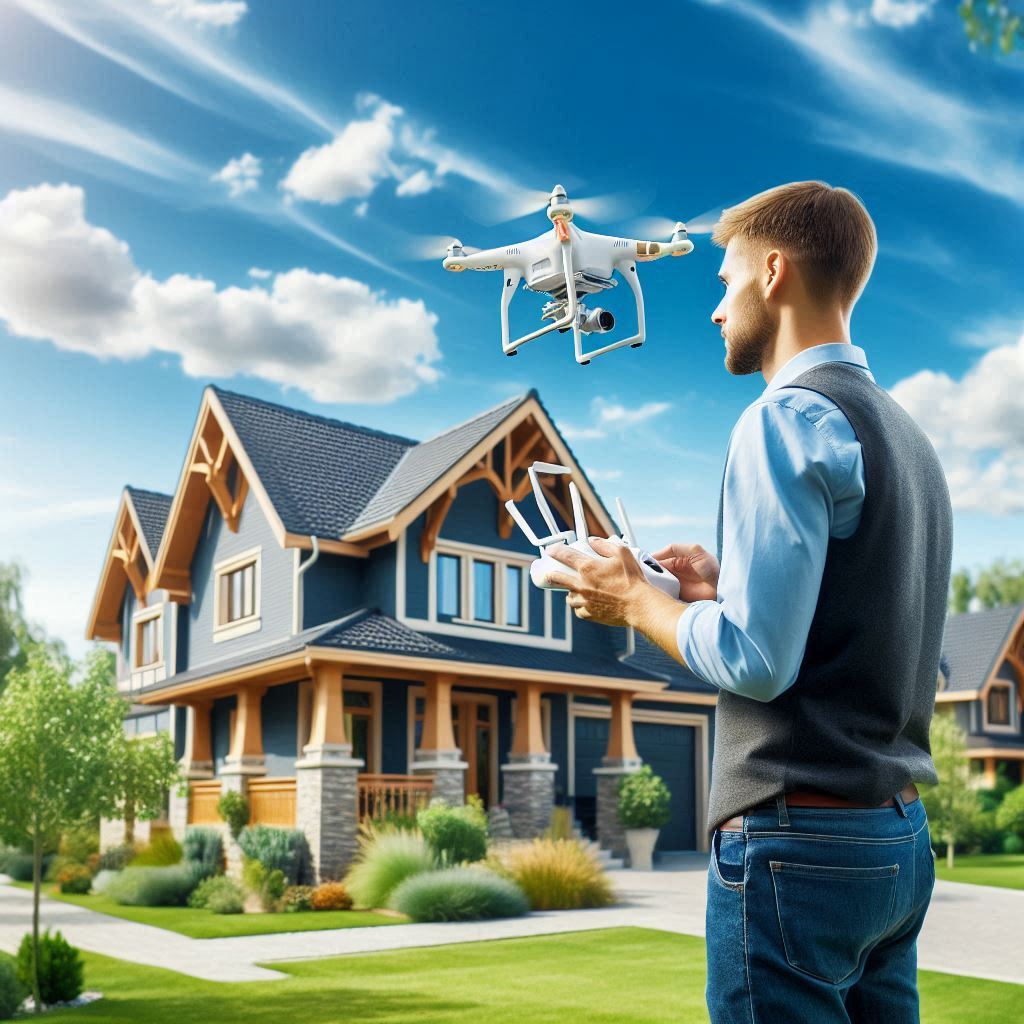
However, recent advancements in technology have given rise to Home Inspections 2.0 – a new era where drones are being utilized to enhance the accuracy and efficiency of home inspections.
One significant benefit of using drones for home inspections is their ability to access areas that may be difficult or dangerous for human inspectors to reach. Drones equipped with high-resolution cameras can easily navigate through tight spaces such as roofs, attics, and crawl spaces.
This enables inspectors to capture detailed images and videos of areas that were previously inaccessible without costly scaffolding or risking injury climbing on ladders.
Moreover, utilizing drones allows inspectors to examine properties from unique angles and perspectives not possible with traditional inspection methods.
By capturing aerial footage, inspectors can gain an overall view of the entire property layout including its surrounding environment. This holistic perspective is particularly advantageous when assessing large estates or properties with extensive outdoor features like swimming pools or landscaping.
Another advantage offered by drone-based home inspections is their ability to gather data quickly and efficiently. Drones can swiftly cover vast areas within minutes compared to hours spent manually inspecting each nook and cranny by foot.
Consequently, this significantly reduces inspection timeframes while improving productivity for both inspectors and clients alike.
The quality of data obtained through drone-based inspections is also worth noting. High-resolution cameras mounted on drones provide crystal-clear images that offer detailed insights into potential issues present within a property structure or exterior surfaces such as windows, chimneys, or gutters.
In addition to visual data gathering capabilities provided by drones’ cameras, thermal imaging technology can further enhance home inspections 2.0 efforts. Equipping drones with thermal cameras enables inspectors to identify hidden problems related to insulation gaps, electrical hotspots, or plumbing leaks.
This innovative approach not only enhances the accuracy of inspections but also provides homeowners with valuable information for improving energy efficiency and preventing potential hazards.
Furthermore, the integration of artificial intelligence (AI) algorithms into drone-based inspections holds immense promise for the future. AI-powered drones have the potential to automatically analyze visual data collected during an inspection and flag any anomalies or areas that require further investigation.
This intelligent automation streamlines the inspection process by reducing human error and making it easier for inspectors to prioritize their findings.
Despite all these advantages, some critics argue that drone-based home inspections lack a personal touch compared to traditional methods involving direct human interaction. While it is true that technology cannot replace interpersonal communication entirely, it is essential to recognize that drone-based inspections do not aim to eliminate human involvement but rather enhance it.
In conclusion, harnessing the power of technology through drone-based home inspections brings numerous benefits to both buyers and sellers in real estate transactions.
By utilizing drones equipped with high-resolution cameras, thermal imaging capabilities, and AI algorithms, inspectors can access hard-to-reach areas efficiently while obtaining accurate and comprehensive data regarding a property’s condition.
As Home Inspections 2.0 continues to evolve, it has become clear that drones are revolutionizing this industry by combining cutting-edge technology with traditional expertise – ultimately benefiting all parties involved in real estate transactions.
How Virtual Reality is Revolutionizing the Home Inspection Process
Home inspections have always been an essential part of the home buying process. Prospective buyers rely on these inspections to uncover any hidden issues or potential problems with a property before making their purchase.
Traditionally, home inspectors would physically visit a property and visually inspect various aspects, such as the structure, plumbing, electrical systems, and more. However, recent advancements in technology have introduced a new era of home inspections – Home Inspections 2.0.
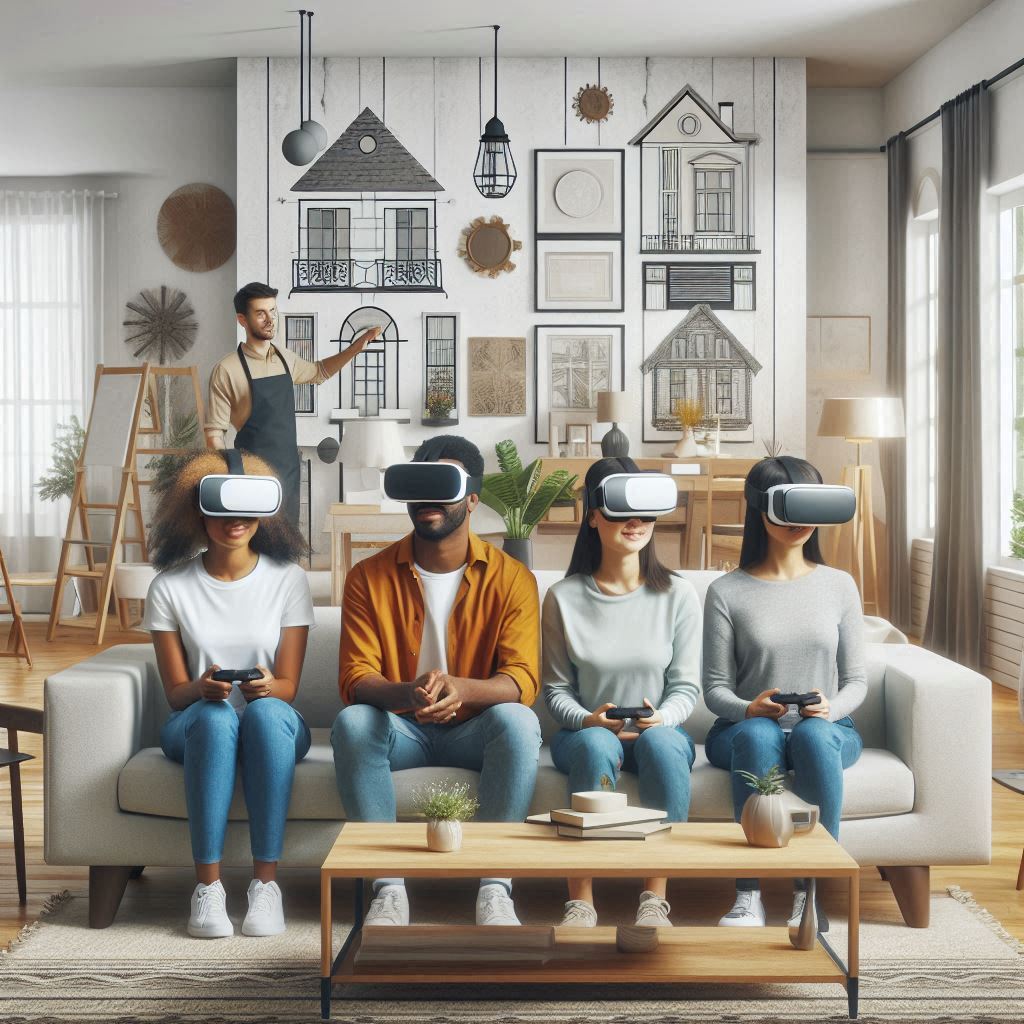
One exciting aspect of Home Inspections 2.0 is the use of virtual reality (VR) technology in the inspection process. Virtual reality offers a simulated environment that can replicate real-world scenarios and enable users to interact with digital elements as if they were physically present in that environment.
By harnessing this technology, home inspectors can now provide clients with immersive experiences that go beyond simple visual observations.
Incorporating virtual reality into home inspections allows for a detailed examination of every nook and cranny without being physically present at the property itself. This means that homeowners who are selling their properties no longer need to accommodate multiple visits from different inspectors during the sales process.
Instead, they can provide access to their property virtually through VR equipment or apps specifically designed for this purpose.
From the buyer’s perspective, virtual reality enhances transparency by allowing them to thoroughly explore all areas of interest within a house without needing physical access. With VR goggles or compatible devices readily available on smartphones or computers connected to specialized software platforms provided by professional inspection companies, buyers can navigate through each room seamlessly while receiving vital information about potential issues simultaneously.
Moreover, virtual reality empowers buyers with unique capabilities during their inspections since it enables them to zoom in on particular areas for closer examinations or even measure spaces accurately using built-in tools integrated into VR applications exclusively developed for these purposes.
Furthermore, virtual reality provides prospective homeowners with valuable insights into how specific changes or renovations may impact a space before committing significant resources toward those endeavors.
By virtually modifying a room’s layout or experimenting with different materials, buyers can gain a realistic understanding of how their vision aligns with the property they are considering. This feature not only helps buyers make more informed decisions but also saves them time and money in the long run by avoiding unnecessary renovations.
Virtual reality technology has also opened up new opportunities for home inspectors to collaborate effectively with experts from various fields during inspections. With VR headsets connected to live streaming capabilities, inspectors can now consult remotely with specialists such as electricians, plumbers, or structural engineers who may be located elsewhere.
This real-time collaboration ensures that potential issues are identified accurately while allowing all parties involved to contribute their expertise without being physically present at the property.
In conclusion, virtual reality is revolutionizing the home inspection process through its ability to provide immersive experiences and enhance transparency for both sellers and buyers. By enabling detailed examinations without physical presence and empowering prospective homeowners with insights into possible modifications, VR is reshaping traditional practices in this field.
Moreover, virtual reality allows for seamless collaboration among professionals from diverse backgrounds during inspections. As technology continues to advance rapidly, it is clear that Home Inspections 2.0 will continue evolving, providing even greater benefits and efficiencies in the future of home buying processes worldwide.
Integrating Artificial Intelligence in Home Inspections 2.0
Home inspections have long been an essential part of the home-buying process, providing potential homeowners with crucial information about the condition of a property. Traditionally, these inspections involved inspectors manually examining various aspects of a house, such as its structure, electrical systems, and plumbing.
However, in recent years, there has been a significant shift towards integrating artificial intelligence (AI) into home inspections to enhance their accuracy and efficiency.

Let me know if you’d like further assistance!
The integration of AI technology in home inspections is known as Home Inspections 2.0. This emerging trend leverages advanced algorithms and machine learning techniques to automate certain aspects of the inspection process. By harnessing the power of technology, Home Inspections 2.0 aims to provide more comprehensive and detailed assessments while reducing human error.
One area where AI can be particularly beneficial is in analyzing images and videos captured during a home inspection. With advancements in computer vision technology, AI algorithms can now identify potential issues that may not be immediately apparent to human inspectors.
For example, by analyzing thermal imaging data or identifying signs of water damage from images or videos captured during an inspection, AI-powered systems can alert inspectors to possible structural issues that require further investigation.
Furthermore, AI can also streamline the inspection process by automating repetitive tasks and improving data collection methods. By using natural language processing techniques combined with voice recognition capabilities, inspectors can dictate their findings directly into an AI system instead of relying on manual note-taking or cumbersome paperwork.
Another advantage offered by Home Inspections 2.0 is predictive analytics based on historical data collected from previous inspections across multiple properties.
Machine learning algorithms can analyze this vast amount of information to identify patterns and trends related to common problems found in homes over time. Armed with this knowledge beforehand allows for proactive measures like suggesting repairs or maintenance work before they become significant issues.
Moreover, incorporating sensors into homes during construction or renovations allows for real-time monitoring of various parameters like temperature fluctuations or air quality levels through IoT devices. AI algorithms can analyze this data continuously, providing homeowners and inspectors with valuable insights into the condition of a property over time.
For example, if temperature fluctuations are detected in certain areas of a house, it could indicate potential insulation problems or issues with HVAC systems that may not be evident during a one-time inspection.
Despite these significant advancements in Home Inspections 2.0, it is essential to note that AI technology should complement human expertise rather than replace it entirely. While AI-powered systems can assist in identifying potential issues and streamlining processes, they cannot entirely replicate the critical thinking and problem-solving skills of human inspectors.
In conclusion, integrating artificial intelligence into home inspections through Home Inspections 2.0 has revolutionized the industry by enhancing accuracy, efficiency, and predictive capabilities.
By leveraging advanced computer vision techniques for image analysis and automating repetitive tasks using natural language processing technologies, AI improves the quality of assessments while reducing errors caused by human factors. Additionally, machine learning algorithms allow for predictive analytics based on historical data collected from previous inspections to proactively address potential issues before they escalate.
However, it is crucial to remember that while AI offers many advantages in home inspections, human expertise remains indispensable for critical thinking and decision-making purposes
Enhancing Accuracy with Advanced Thermal Imaging Technology
In the world of home inspections, accuracy is key. Buyers and sellers rely on these inspections to provide them with a detailed assessment of a property’s condition. Traditionally, home inspectors have relied on their expertise and visual observation to identify potential issues. However, advancements in technology have revolutionized this industry, allowing for more precise and efficient inspections.
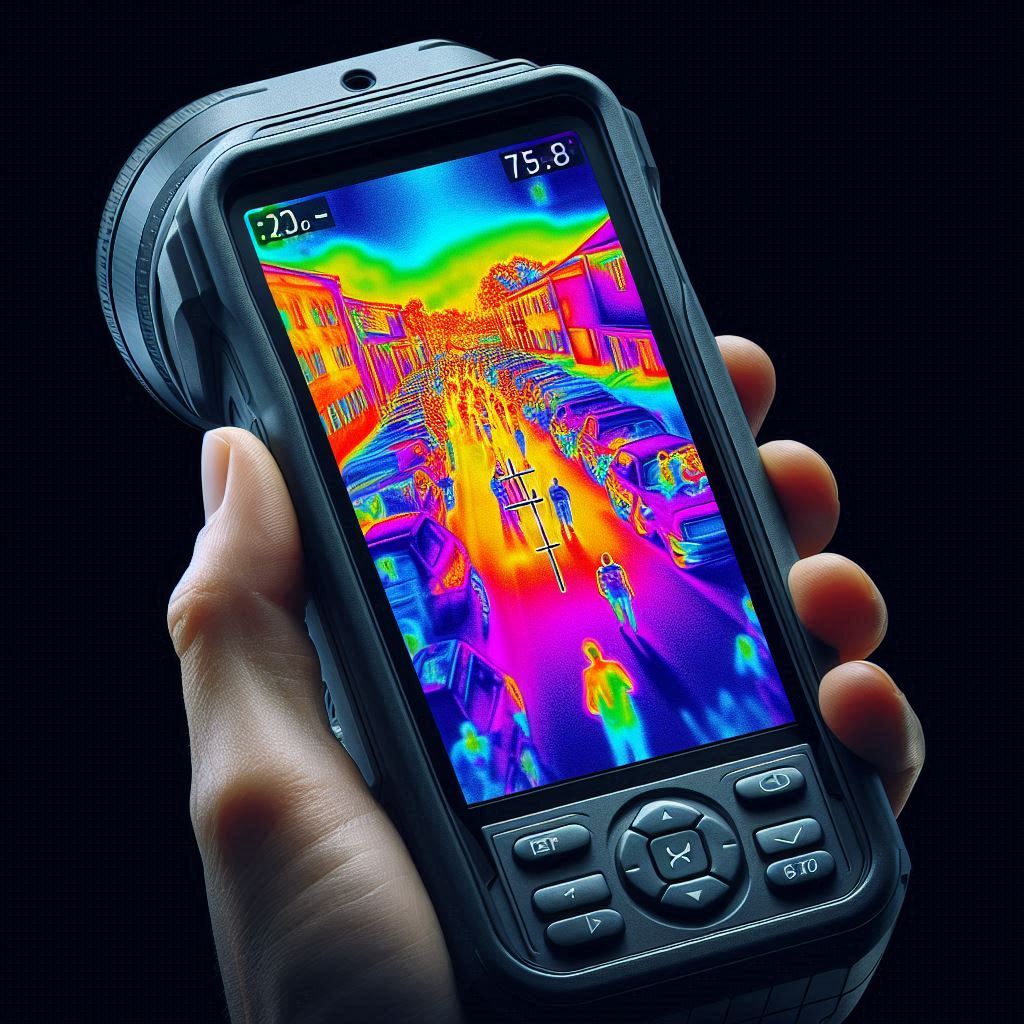
One such technological advancement that has transformed the field of home inspections is thermal imaging technology. This cutting-edge tool utilizes infrared cameras to detect variations in temperature that may indicate hidden problems within a property’s structure or systems. By harnessing the power of thermal imaging technology, home inspectors can now offer their clients an even more comprehensive evaluation.
The primary advantage of thermal imaging technology lies in its ability to identify invisible defects within a property’s components. For instance, leaks or water damage behind walls are often undetectable through visual inspection alone. With thermal imaging cameras, however, inspectors can easily locate areas where heat signatures deviate from normal patterns – indicating potential moisture buildup or insulation deficiencies.
Moreover, thermal imaging can be instrumental in detecting electrical issues that may pose safety hazards for homeowners. Faulty wiring or overloaded circuits can generate excessive heat which may not be visible without specialized equipment like thermal imagers. These devices enable inspectors to pinpoint hotspots that require immediate attention before they develop into major problems.
Additionally, by utilizing advanced software programs integrated with these infrared cameras, inspectors can analyze captured images more effectively than ever before. This analysis includes measuring temperatures accurately across various surfaces as well as creating detailed reports documenting any identified anomalies during the inspection process.
By adopting this state-of-the-art technology into their practices, professional home inspectors significantly enhance the quality and reliability of their assessments while also improving client satisfaction rates considerably.
Despite its many benefits though, it is important to note that thermal imaging should not replace other crucial inspection methods entirely. Instead, it should be regarded as a complementary tool that aids in identifying potential issues that might otherwise go unnoticed.
Furthermore, it is vital for home inspectors to receive proper training and certification in order to fully utilize thermal imaging technology effectively. As with any new instrument, there is a learning curve involved when interpreting the images captured by infrared cameras. Therefore, industry professionals must invest time and resources into acquiring the necessary skills to operate this technology accurately.
In conclusion, advances in thermal imaging technology have revolutionized the field of home inspections. With these cutting-edge tools at their disposal, home inspectors can provide clients with more accurate and comprehensive evaluations of properties. From identifying hidden moisture issues behind walls to pinpointing electrical hazards before they become dangerous, thermal imaging enhances the overall accuracy of inspections.
However, it is important to remember that this technology does not replace traditional inspection methods but rather supplements them. With proper training and expertise, home inspectors can harness the power of advanced thermal imaging technology to offer superior service and peace of mind to buyers and sellers alike.
The Role of Smart Home Devices in Streamlining Inspections
Home inspections have long been an integral part of the home buying process. Traditionally, these inspections were conducted by a trained professional who would assess various aspects of the property to identify any potential issues or areas in need of repair. However, with the advent of technology and the rise of smart home devices, a new era of home inspections has emerged – one that harnesses the power of technology to streamline and enhance this important process.

Smart home devices, such as thermostats, security systems, and even appliances connected to the Internet of Things (IoT), are becoming increasingly popular among homeowners. These devices offer numerous benefits in terms of convenience and efficiency but can also play a significant role in improving home inspections. By integrating these smart devices into the inspection process, inspectors can gather more accurate data and provide more comprehensive reports to their clients.
One way that smart home devices aid in streamlining inspections is through real-time monitoring. For example, a smart thermostat can provide valuable information about temperature fluctuations throughout different rooms in a house.
This data not only helps inspectors identify potential issues with heating or cooling systems but also provides insight into overall energy efficiency. By analyzing this information alongside other key factors such as insulation quality or window seals, inspectors can paint a clearer picture for buyers regarding both short-term comfort and long-term cost savings.
Similarly, security systems equipped with motion sensors and cameras can contribute greatly to home inspections. These devices allow inspectors to remotely monitor specific areas within a property without physically being present on-site at all times.
In addition to enhancing safety during inspections by providing real-time alerts about unauthorized access or potential dangers like water leaks or fire hazards detected by smoke detectors linked to these systems; they also offer convenience when conducting multiple simultaneous assessments across different properties located miles apart from each other.
Another advantage provided by smart home devices is their ability to collect historical data over time automatically. For instance, sensors installed on plumbing fixtures could detect variations in water pressure or flow rates, alerting inspectors to potential issues such as clogged pipes or leaks that may not be immediately apparent during a visual inspection. By analyzing this historical data alongside other relevant factors, inspectors can make more accurate assessments of the condition of a property and advise buyers accordingly.
Furthermore, smart home devices also simplify the communication process between homeowners and inspectors. Through cloud-based platforms or mobile applications, homeowners can grant access to inspectors remotely without needing to be physically present on-site. This feature allows for increased flexibility in scheduling inspections while also providing convenience for both parties involved.
Despite these numerous benefits offered by smart home devices in streamlining inspections, it is important to note that their integration does not replace the expertise and experience of professional home inspectors. Instead, it complements their abilities by augmenting data collection and analysis processes. The human factor remains essential in interpreting the gathered information and making informed judgments regarding a property’s condition.
In conclusion, technology has revolutionized various industries across the globe – including real estate. With smart home devices becoming increasingly prevalent in households today, they offer significant advantages when integrated into home inspections. From real-time monitoring to historical data collection and simplified communication channels, these devices enhance efficiency while ensuring accuracy throughout the assessment process.
As technology continues to evolve rapidly within our society, harnessing its power becomes vital in shaping a smarter future for all aspects related to residential properties – including home inspections 2.0
Utilizing Big Data Analytics to Improve Inspection Efficiency
In recent years, technological advancements have revolutionized numerous industries, and the field of home inspections is no exception. With the emergence of Home Inspections 2.0, professionals in this industry are now able to harness the power of technology to improve their efficiency and accuracy.
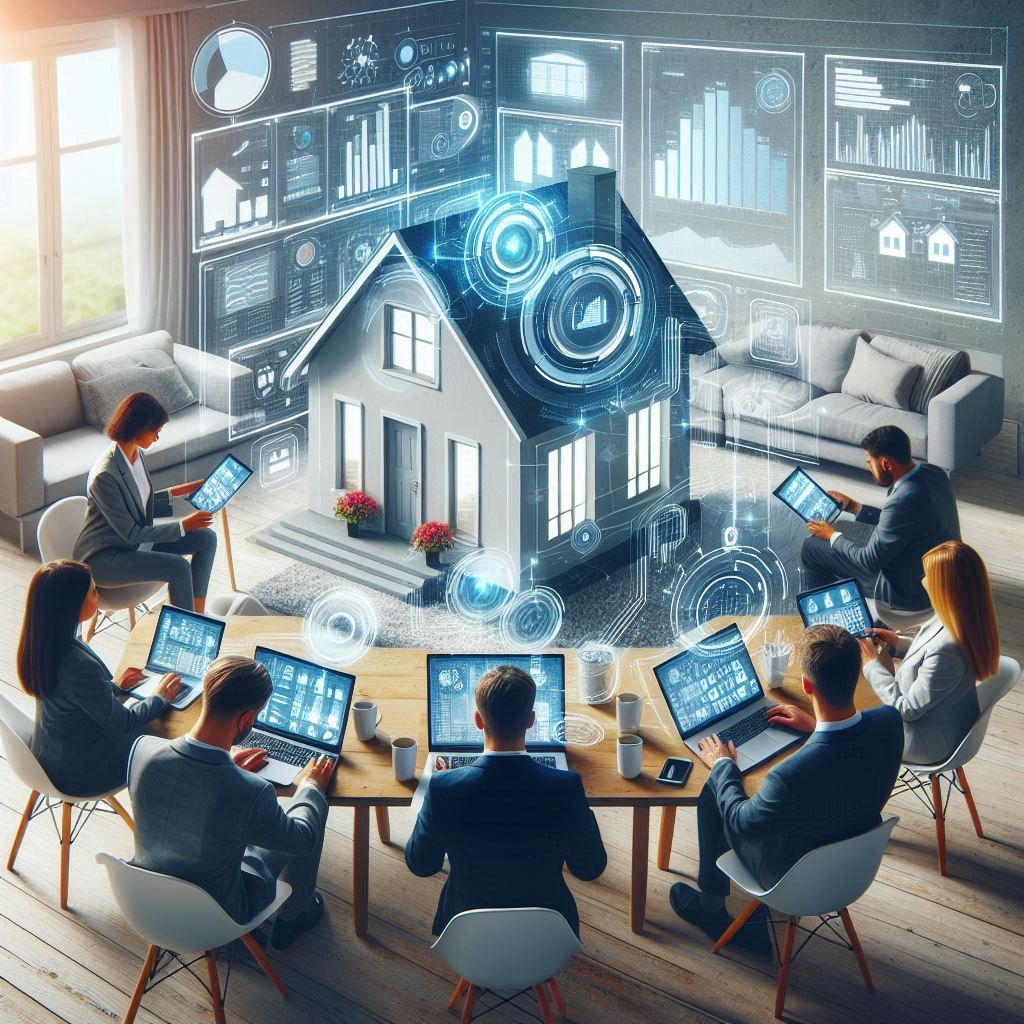
One significant way that technology has transformed home inspections is through the utilization of big data analytics. By analyzing vast amounts of data collected during an inspection process, inspectors can gain valuable insights into a property’s condition and identify potential issues more efficiently.
Big data analytics enable inspectors to examine a wide range of factors simultaneously. This includes evaluating structural integrity, assessing electrical systems, examining plumbing fixtures, inspecting HVAC units, and much more. By leveraging advanced algorithms and machine learning techniques, these tools can analyze patterns within massive datasets to detect anomalies or identify hidden problems that may not be apparent during a manual inspection.
Furthermore, utilizing big data analytics allows for predictive modeling in home inspections. Through historical analysis combined with current information gathered during an inspection process, inspectors can forecast future maintenance requirements or estimate potential repair costs accurately. This predictive capability provides homeowners with invaluable knowledge about their property’s long-term needs and helps them plan accordingly.
Another advantage offered by big data analytics in home inspections is increased speed and efficiency. In traditional inspection processes without technological support, gathering necessary information could be time-consuming due to various factors such as human error or incomplete records from previous owners or tenants.
However, by implementing digital tools powered by big data analytics into the inspection workflow, these challenges become significantly mitigated. The ability to quickly access comprehensive property information eliminates tedious manual tasks often associated with paperwork-heavy processes while enabling inspectors to focus on identifying critical issues promptly.
Moreover, digital platforms integrated with big data analytics provide real-time updates throughout the inspection process – both for homeowners and other stakeholders involved in the transaction. This transparency allows for improved communication and facilitates a smoother exchange of information, ensuring that everyone is on the same page regarding the property’s condition.
Additionally, big data analytics can also contribute to more accurate risk assessments in home inspections. By leveraging historical data from numerous properties, these tools allow inspectors to identify common patterns or trends associated with specific risks or deficiencies. This knowledge enables them to prioritize their focus during an inspection and allocate resources efficiently.
Furthermore, big data analytics can assist in streamlining the inspection report creation process. With digital platforms designed specifically for this purpose, inspectors can input their findings directly into a database during an inspection. These platforms often come equipped with pre-defined templates and standardized formats that ensure consistency across reports while minimizing manual effort required for compiling information after the fact.
In conclusion, technology has brought about significant advancements in the field of home inspections through the utilization of big data analytics. These tools empower inspectors to analyze vast amounts of data efficiently, providing valuable insights into a property’s condition and potential issues. The benefits range from increased speed and efficiency to enhanced accuracy in risk assessments and predictive modeling capabilities. As Home Inspections 2.0 continues to evolve, it is clear that harnessing the power of technology will play a crucial role in shaping its future landscape – benefiting both homeowners and industry professionals alike.
Implementing Mobile Apps for Real-Time Reporting and Documentation
In today’s fast-paced world, technology plays a crucial role in almost every aspect of our lives. The field of home inspections is no exception, as professionals in this industry are constantly seeking ways to streamline their processes and deliver more efficient services to their clients. One area where technology has made significant advancements is in the implementation of mobile apps for real-time reporting and documentation.
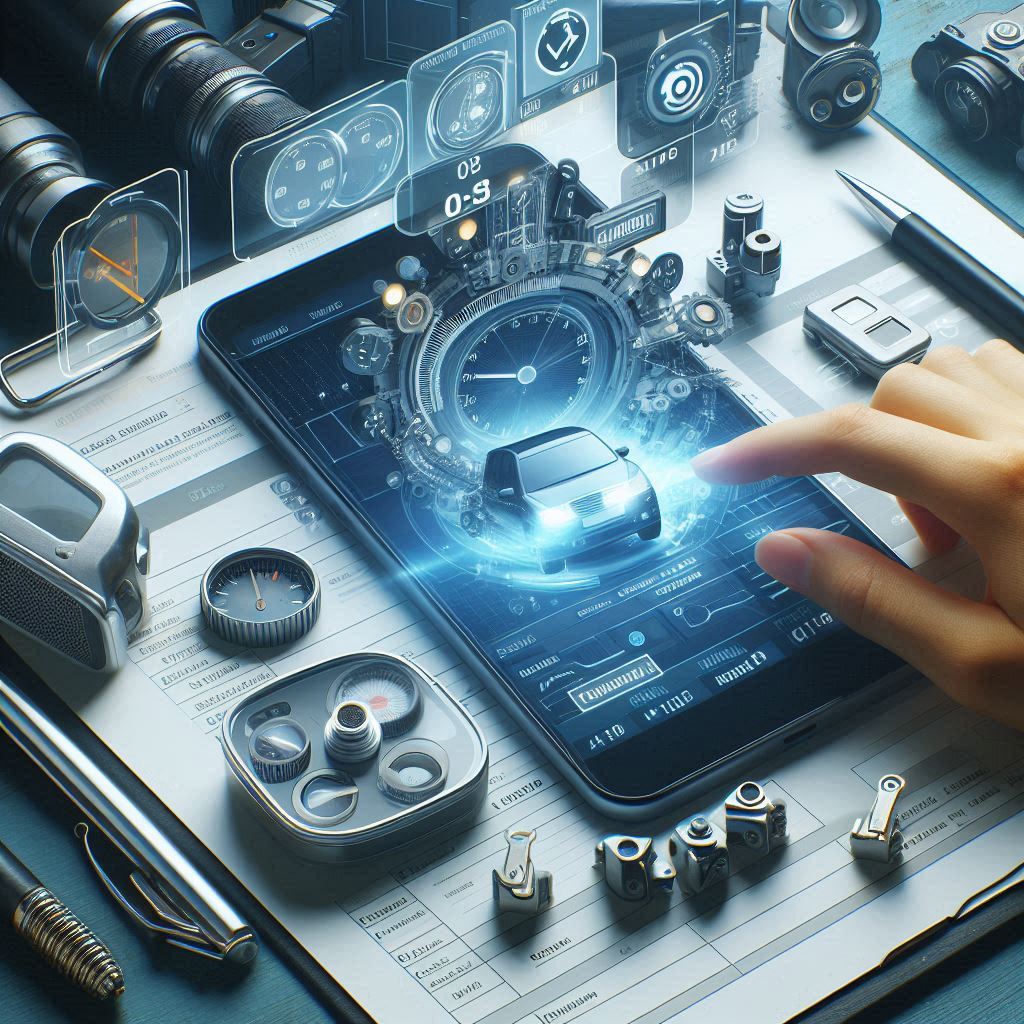
Gone are the days when home inspectors had to rely on pen and paper or bulky digital cameras to document their findings during an inspection. With the advent of smartphones and tablets, inspectors now have access to a wide range of mobile apps specifically designed for this purpose. These apps allow them to take photos, record videos, and make notes directly on their devices while they conduct the inspection.
The advantages of using mobile apps for real-time reporting and documentation are numerous. Firstly, these apps eliminate the need for manual data entry once the inspection is complete. Inspectors can input all relevant information into the app as they go along, ensuring accuracy and efficiency throughout the process.
Furthermore, mobile apps enable inspectors to capture high-quality visual evidence with ease. Rather than relying solely on written descriptions that may leave room for interpretation, inspectors can now supplement their reports with clear photographs or videos taken directly from their devices during an inspection. This not only enhances communication between inspector and client but also provides a more comprehensive understanding of any issues that may be present.
Another benefit offered by these mobile apps is real-time reporting capability. Inspectors can generate detailed reports instantly upon completing an inspection without having to return to an office or spend hours transcribing handwritten notes onto a computer later on. This allows them to provide prompt feedback to clients while still being onsite – giving them a competitive edge in terms of customer service.
Moreover, these mobile apps often come equipped with features that facilitate efficient documentation management. Inspectors can organize their reports, photos, and videos in a structured manner within the app itself. This eliminates the risk of misplacing or losing crucial information and ensures that everything is readily accessible whenever needed.
Additionally, many mobile apps offer cloud-based storage solutions for home inspection data. This means that all documentation is securely stored online and can be accessed from anywhere with an internet connection – providing convenience and peace of mind to both inspectors and clients alike.
Of course, it is important to note that while technology has undoubtedly revolutionized the field of home inspections, it should not replace the expertise and experience of a qualified professional. Mobile apps should be seen as tools to enhance efficiency rather than a substitute for human judgment.
In conclusion, implementing mobile apps for real-time reporting and documentation has become increasingly prevalent in the field of home inspections. These apps offer numerous advantages such as eliminating manual data entry, enhancing visual evidence capture, enabling real-time reporting capability, facilitating efficient documentation management, and providing cloud-based storage solutions.
However, it is crucial to remember that these apps are meant to support professionals rather than replace them entirely. With technology continuously evolving at a rapid pace, we can expect further advancements in this area as home inspectors continue harnessing its power for more effective service delivery in the future.
Exploring Augmented Reality for Interactive Home Inspections
Home inspections have long been a crucial part of the home-buying process, providing potential buyers with essential information about the condition of a property. Traditionally, these inspections involve an inspector physically visiting the property and conducting a thorough assessment to identify any issues or defects.
However, with advancements in technology, there is now an exciting opportunity to revolutionize this process through augmented reality (AR) for interactive home inspections.
Augmented reality refers to the integration of digital content into our real-world environment. It overlays computer-generated graphics onto our perception of the physical world using devices such as smartphones or tablets. This technology has gained significant traction in various industries, including gaming and entertainment. However, its potential applications extend far beyond these realms.
One area where AR shows promise is in improving home inspections by enhancing interactivity and convenience for both inspectors and buyers alike. Imagine being able to walk through a virtual representation of a house while simultaneously viewing relevant inspection data overlaid on each room or component within it.
With AR-powered tools like smart glasses or headsets, inspectors can access detailed information about a property without having to physically examine every nook and cranny. They can easily identify potential issues that may not be immediately visible or detectable during traditional visual assessments.
Furthermore, augmented reality can facilitate collaboration between multiple stakeholders involved in the inspection process. Inspectors can remotely guide clients through a virtual tour of the property while pointing out specific areas of concern directly within their field of view. This real-time interaction enables clients to actively participate in the inspection process instead of merely relying on static reports.
In addition to facilitating remote collaboration, AR-enhanced home inspections also offer benefits in terms of documentation and record-keeping. By capturing digital images or videos overlaid with relevant inspection details during an interactive walkthrough, inspectors can create comprehensive reports that are easy to understand for clients later on.
Moreover, AR technology allows for precise measurement capabilities within virtual spaces. Instead of carrying measuring tapes or laser devices, inspectors can simply use AR tools to measure dimensions accurately. This not only saves time but also reduces the risk of errors or inaccuracies in measurements.
Of course, implementing AR for home inspections does come with some challenges. One primary concern is the cost associated with acquiring and maintaining the necessary technology infrastructure. Additionally, there may be a learning curve for both inspectors and clients who are unfamiliar with AR tools.
To address these challenges, it is essential to invest in training programs and educational resources that familiarize industry professionals with the capabilities and benefits of augmented reality in home inspections. Moreover, collaboration between technology developers and inspection organizations can help create user-friendly interfaces and streamlined workflows specific to this domain.
In conclusion, augmented reality has the potential to transform traditional home inspections into interactive experiences that offer greater convenience, efficiency, and accuracy. By harnessing this technology’s power, inspectors can enhance their assessments while empowering clients to actively participate in the process. Although there are obstacles to overcome, continued exploration of augmented reality for interactive home inspections holds great promise for improving an essential aspect of real estate transactions.
The Importance of Cybersecurity in Technologically-Driven Inspections
The rapid advancement of technology has undoubtedly transformed various industries, including the home inspection industry. With the emergence of Home Inspections 2.0, inspectors are now equipped with powerful tools and software that enhance their ability to thoroughly assess a property’s condition. However, this increasing reliance on technology brings with it new challenges, particularly in terms of cybersecurity.
In today’s digitally-driven world, where sensitive information is constantly being exchanged online, maintaining strong cybersecurity measures is paramount. Home inspectors often handle vast amounts of personal data from clients during inspections. This includes financial information such as bank statements and mortgage details, as well as personal information like social security numbers and addresses. Safeguarding this data against cyber threats should be a top priority for all professionals in the field.
One major concern in relation to cybersecurity is the potential for hackers to gain unauthorized access to sensitive client information through unsecured networks or devices used during inspections. Inspectors typically rely on mobile devices or laptops connected to Wi-Fi networks while conducting inspections on-site. If these networks are not adequately protected, they become vulnerable entry points for malicious actors seeking valuable data.
To counteract this threat, it is imperative that home inspectors take necessary precautions by using secure network connections and encrypting any transferred data during inspections. Implementing virtual private network (VPN) solutions can significantly minimize risks associated with insecure networks by creating encrypted tunnels between the inspector’s device and servers where data is stored or processed.
Moreover, adopting stringent password management practices can greatly enhance an inspector’s overall cybersecurity posture. Using unique and complex passwords across different platforms ensures that even if one account becomes compromised due to a breach elsewhere, other accounts remain secure.
While protecting sensitive client data should be prioritized by individual inspectors themselves; governments and regulatory bodies also have an important role to play in ensuring adequate cybersecurity within the home inspection industry. Enforcing strict standards and regulations can help create a culture where cybersecurity becomes ingrained into every aspect of the inspection process.
Furthermore, technology companies that develop and provide inspection software have a responsibility to prioritize cybersecurity in their products. This can include implementing robust encryption measures, regularly updating software to address vulnerabilities, and conducting thorough security audits to identify potential weaknesses.
Another aspect of cybersecurity that home inspectors must consider is the protection of their own professional reputation. In an era where consumers are increasingly aware of data breaches and privacy concerns, any compromise in cybersecurity can lead to a loss of trust from clients. Not only does this damage the inspector’s business, but it also has broader implications for the entire industry as clients may become wary of utilizing technological advancements in inspections altogether.
In conclusion, while Home Inspections 2.0 brings numerous benefits to the home inspection industry, such as increased efficiency and accuracy; it also introduces new risks that must be addressed effectively. Cybersecurity should be treated as an integral part of every home inspector’s workflow by adopting secure network connections, encrypting data transfers during inspections, practicing strong password management techniques, and adhering to industry regulations.
By taking these proactive measures to protect sensitive client information and maintain professional integrity through adequate cybersecurity practices; inspectors can continue harnessing the power of technology while preserving trust within their field
Adapting Blockchain Technology for Transparent and Secure Inspection Records
The world is rapidly advancing in terms of technology, and various industries are embracing these advancements to improve their processes and enhance customer experience. The home inspection industry is no exception, as it continues to evolve with the integration of new technologies. One technology that has shown great promise in revolutionizing the home inspection process is blockchain.
Blockchain technology is most commonly associated with cryptocurrencies such as Bitcoin, but its potential reaches far beyond digital currencies. At its core, blockchain is a decentralized and transparent ledger system that records transactions or any other form of data. This transparency and security make it an ideal solution for creating immutable inspection records.
Traditionally, home inspection reports were stored on paper or digitally on centralized servers owned by individual inspectors or companies. While this allowed for easy access to records, it also made them susceptible to tampering or loss due to human error or technical issues. With blockchain technology, these concerns become obsolete.
By implementing blockchain into the home inspection process, every detail recorded during an inspection can be securely stored on a decentralized network of computers known as nodes. Each node maintains a copy of the entire transaction history (or in this case, the inspection record) making it nearly impossible for anyone to alter past entries without consensus from all participants in the network.
Furthermore, because each entry added onto the blockchain contains a unique identifier called a hash code, any attempt at altering previous entries would require changing subsequent entries as well – an arduous task that would raise immediate suspicion among participants in the network.
This level of transparency ensures that clients can have complete trust in their home inspections’ integrity while offering peace of mind knowing that their valuable documents are secure and cannot be manipulated after-the-fact.
In addition to ensuring transparent and secure records management, adopting blockchain technology for home inspections introduces several other benefits:
Firstly, since each entry onto the blockchain must undergo verification through consensus mechanisms, such as proof-of-work or proof-of-stake, the accuracy of the recorded data is inherently enhanced. This eliminates any doubts about the authenticity or credibility of inspection reports.
Secondly, blockchain technology allows for more efficient and streamlined communication between all parties involved in a home inspection – homeowners, inspectors, real estate agents, and potential buyers. With a shared platform accessible to all authorized participants, everyone can have real-time access to relevant information and updates regarding the inspection process.
Moreover, by integrating smart contracts into blockchain-based home inspections systems, transactions such as scheduling appointments or making payments can be automated with predetermined conditions. This reduces human error and ensures that all necessary steps are taken in a timely manner throughout the entire inspection process.
Lastly, embracing blockchain technology aligns home inspections with other industries that have already harnessed its potential. For example, insurance companies could benefit from having direct access to transparent records when underwriting policies for new homeowners. Additionally, government agencies could utilize blockchain-powered records during property assessments or tax audits.
In conclusion, adopting blockchain technology for transparent and secure inspection records has great potential to enhance efficiency and trust within the home inspection industry. By leveraging this decentralized ledger system along with smart contracts and real-time information sharing capabilities between all stakeholders involved in a home inspection transaction – clients can feel confident knowing their valuable assets are protected while also streamlining communication among key players throughout the process.
Impact of Internet of Things (IoT) on Home Inspections
With the rapid advancement of technology, the Internet of Things (IoT) has emerged as a game-changer in various industries. Its impact on home inspections cannot be overlooked. The IoT refers to the network of interconnected devices that can collect and exchange data without human intervention. In the context of home inspections, this means that everyday objects within a house can now be connected to the internet and provide valuable information about their condition and performance.
One significant way in which the IoT revolutionizes home inspections is through smart sensors. These sensors are embedded in appliances, systems, and even structural components of a house to monitor their functioning continuously. For example, smart thermostats can track temperature variations throughout different rooms and adjust accordingly for optimal comfort and energy efficiency. Similarly, water leakage detectors can identify any leaks or potential plumbing issues before they cause significant damage.
By utilizing these smart sensors during home inspections, inspectors gain access to real-time data about various aspects of a property’s condition. This eliminates the need for manual checks or relying solely on visual observations during an inspection process. Inspectors can now rely on accurate sensor readings to assess factors such as temperature fluctuations, humidity levels, air quality, water flow rates, electrical consumption patterns, and much more.
Moreover, by leveraging cloud computing capabilities along with IoT devices, home inspection professionals have greater flexibility in accessing data remotely. This means that inspectors no longer need to physically visit properties for every inspection task but can access critical information from anywhere using internet-enabled devices such as smartphones or laptops. This convenience not only saves time but also allows for efficient scheduling of multiple inspections simultaneously.
Another area where IoT greatly impacts home inspections is predictive maintenance. With historical sensor data collected over time from different homes across similar environments or regions available at hand thanks to cloud-based analytics platforms powered by AI algorithms – it becomes possible to identify patterns indicative of potential equipment failures before they occur.
This proactive approach helps homeowners avoid costly repairs by addressing issues at their early stages. For instance, HVAC systems can be monitored for irregularities in performance or signs of wear and tear, allowing homeowners to schedule maintenance or replacements before a breakdown occurs. The same applies to electrical systems, plumbing networks, and other critical components of a house.
Furthermore, the IoT’s influence extends beyond individual homes. It also enables more comprehensive inspections of entire neighborhoods or communities. By aggregating data from multiple homes within a specific area, patterns and trends related to common issues can be identified. This information is invaluable for local authorities, construction companies, and urban planners as they make informed decisions about infrastructure development or renovations.
In conclusion, the Internet of Things has brought significant advancements to the field of home inspections. With smart sensors providing real-time data on various aspects of a property’s condition and cloud-based analytics facilitating remote access and predictive maintenance capabilities – home inspectors are equipped with powerful tools that enhance efficiency while minimizing costs for homeowners.
Moreover, the ability to analyze aggregated data from multiple properties allows for broader insights into neighborhood-wide issues. As technology continues to evolve rapidly in this digital age, it is clear that home inspections 2.0 are here to stay by harnessing the power of IoT innovation
Conclusion
In conclusion, Home Inspections 2.0 is a concept that leverages the power of technology to improve the efficiency and accuracy of home inspections. Through the use of advanced tools such as drones, thermal imaging cameras, and digital reporting software, inspectors are able to identify potential issues in homes more effectively.
This not only saves time but also provides homeowners with comprehensive reports that help them make informed decisions about their properties. With Home Inspections 2.0, the inspection process becomes more reliable and convenient for both inspectors and homeowners alike.
